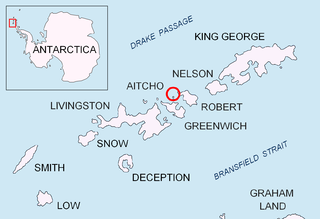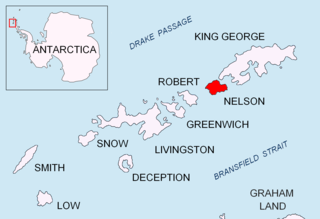
Quito Glacier is a glacier draining the northeast slopes of Mount Plymouth and flowing northeastwards into the sea west of Canto Point in north Greenwich Island, South Shetland Islands. It was named after the capital of Ecuador, c. 1990, by the Ecuadorian Antarctic Expedition.

McFarlane Strait is a strait lying between Greenwich Island and Livingston Island, in the South Shetland Islands off Antarctica. It is 24 kilometres (13 nmi) long and 3 kilometres (1.6 nmi) wide. The name appears on an 1822 chart by Captain George Powell, a British sealer, and is now well established in international usage.

Morton Strait is the 9 km (4.9 nmi)-long and 6.2 km (3.3 nmi)-wide strait between Snow Island on the southwest and Rugged Island and Livingston Island on the northeast, in the South Shetland Islands, Antarctica. The Aim Rocks and Long Rock lie in the strait.

Emeline Island is a conspicuous rocky island rising to over 100 m (328 ft) in the Aitcho group on the west side of English Strait in the South Shetland Islands, Antarctica. The island extends 550 by 320 m with a surface area of 18 hectares. The area was visited by early 19th century seal hunters.

Table Island is a conspicuous flat-topped, rocky island lying north of Greenwich Island and north-northwest of the Aitcho group on the west side of English Strait in the South Shetland Islands, Antarctica. The island is rising to over 150 metres and extending 1.4 by 1 kilometre, with a surface area of 112 hectares. It is separated from Aitcho Islands to the south-southeast by the 1.9-kilometre (1.2-mile) wide Klimash Passage.

Morris Rock is a rock outcropping that rises to 55 m (180 ft) in the northwest extremity of the Aitcho group, English Strait in the South Shetland Islands, Antarctica. The area was visited by early 19th century sealers.

Caraquet Rock is a rock lying nearly 4 nautical miles (7 km) west-southwest of Bell Point, off the west part of King George Island in the South Shetland Islands. It was named by the UK Antarctic Place-Names Committee in 1960 for the sealing vessel Caraquet from Liverpool, which visited the South Shetland Islands in 1821–22.

Upton Rock is a rock lying 3 nautical miles (6 km) northwest of Flat Top Peninsula, King George Island, in the South Shetland Islands. Named by the United Kingdom Antarctic Place-Names Committee (UK-APC) in 1961 for Benjamin Upton, Master of the American sealing vessel Nancy from Salem, MA, which visited the South Shetland Islands in 1821–22.

Folger Rock is a rock lying 2.5 nautical miles (5 km) north of Harmony Point, Nelson Island, in the South Shetland Islands. It was named by the UK Antarctic Place-Names Committee in 1961 for Tristan Folger, the Master of the American sealing vessel William and Nancy from Nantucket, which visited the South Shetland Islands in 1820–21, operating from nearby Harmony Cove.

Livonia Rock is a rock lying 0.5 nautical miles (1 km) south of Cape Melville, the eastern extremity of King George Island, in the South Shetland Islands, Antarctica. It was named by the UK Antarctic Place-Names Committee in 1960 for the sealing vessel Livonia from London, which visited the South Shetland Islands in 1821–22.

Sinbad Rock is a low rock lying 1.25 nautical miles (2.3 km) west-northwest of Square End Island, off the west end of King George Island, in the South Shetland Islands. The rock was charted in 1935 by DI personnel on the Discovery II but the name appears to be first used on a 1948 Admiralty chart based upon this survey.
Tenorio Rock is a rock 0.4 nautical miles (0.7 km) offshore in western Discovery Bay, Greenwich Island, South Shetland Islands. The name derives from the forms "Islote Tenorio" and "Islote Aviador Tenorio" used on Chilean hydrographic charts of the 1950s. Humbert Tenorio Island was second pilot of the Sikorsky helicopter employed by the Chilean Antarctic Expedition of 1947.

Meldia Rock is the rock of diameter 220 m and split in east-west direction, lying off the northwest coast of Nelson Island in the South Shetland Islands, Antarctica. The area was visited by early 19th century sealers.

Akin Island is a wide, rocky island 280 m long in southeast-northwest direction and 100 m lying off the north coast of Nelson Island in the South Shetland Islands, Antarctica. It is “named after Akin Point on the Bulgarian Black Sea Coast.”
Triznatsi Rocks is the group of three adjacent rocks off the northwest coast of Nelson Island in the South Shetland Islands, Antarctica extending 144 m in west–east direction and 122 m in south–north direction. Their surface areas are 0.33 ha, 0.17 ha and 0.14 ha respectively. The vicinity was visited by early 19th century sealers.
Bris Rock is the rock off the northwest coast of Nelson Island in the South Shetland Islands, Antarctica extending 70 m in south–north direction and 60 m in west–east direction. Its surface area is 0.21 ha. The vicinity was visited by early 19th century sealers.
Chorobates Rock is the rock off the NW coast of northwest coast of Nelson Island in the South Shetland Islands, Antarctica extending 83 m in south–north direction and 55 m in west–east direction. Its surface area is 0.25 ha. The vicinity was visited by early 19th century sealers.
Odometer Rock is the rock off the NW coast of northwest coast of Nelson Island in the South Shetland Islands, Antarctica extending 40 m in west–east direction and 30 m in south–north direction. Its surface area is 0.07 ha. The vicinity was visited by early 19th century sealers.
Besson Rock is the rock off the northwest coast of Nelson Island in the South Shetland Islands, Antarctica extending 45 m in southeast–northwest direction and 32 m in southwest–northeast direction. Its surface area is 0.09 ha. The vicinity was visited by early 19th century sealers.
Cosmolabe Rock is the rock off the NW coast of northwest coast of Nelson Island in the South Shetland Islands, Antarctica extending 120 m in southeast–northwest direction and 50 m wide. Its surface area is 0.23 ha. The vicinity was visited by early 19th century sealers.

![]() This article incorporates public domain material from "Nancy Rock". Geographic Names Information System . United States Geological Survey.
This article incorporates public domain material from "Nancy Rock". Geographic Names Information System . United States Geological Survey. 




